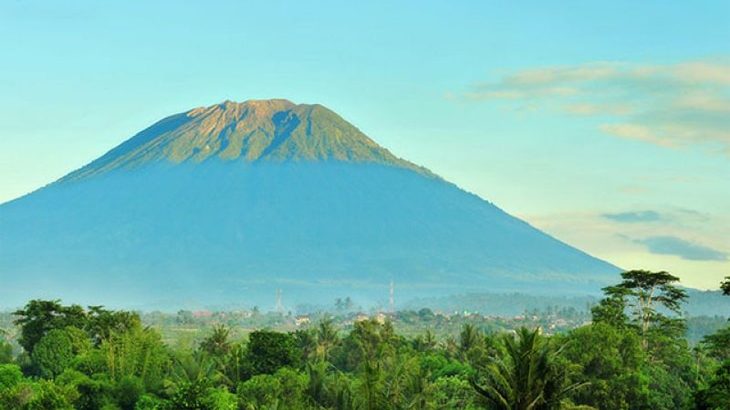Mount Agung also known as Gunung Agung is the highest point in Bali. This volcanic mountain is located on the eastern corner of Bali. With its 9,944 ft Mount Agung absolutely dominates the surroundings. This mountain is very often covered in clouds, which gives it an almost mystical look.
Mount Agung has a great significance in the Balinese culture and spiritual life. For them this remarkable mountain represents the Mount Meru or the universe’s central axis. According to one of the legends this volcanic mountain is one part of the Mount Meru which was given to Bali by one of the very first priests. In addition, one of the most important temples in Bali, Pura Besakih, is situated exactly on the Mount Agung.
The last eruption occurred in the early 1960’s. Almost 2,000 were killed because of the volcano eruption. The Mother Temple of Besakih was luckily missed the rivers of lava literally by a few yards. As expected this miraculous event had its appropriate interpretation in the Balinese culture. The island had been punished for its sins by the gods, but at the same time the hope survived in this temple.
For the recreational purposes the tourists can use the two existing routes which can take them to the top of the mountain. First starts in Besakih and goes through the western part of the mountain. Second route uses the southern part. This second route starts in Pura Pasar Agung very close to Selat. For this tour approximately four hours in one direction are required. It is very important to emphasize that the only possibility to start your journey from one route and to finish it using the second route is available in the dry season. In addition, for this kind of an adventure the tourists are strongly advised to use the services of the professional guides. Sometimes, this journey to the top of this mysterious mountain can last more than four hours and can include the danger of getting lost.
The guides can be found in Besakih and Pura Pasar Agung. The first path from the western direction is considered to be more difficult compared to the second which goes through the southern part of the mountain. In most of the cases climbing starts early in the evening with the clear aim to arrive in the morning of the following day and to enjoy in the new day’s dawn from the mountain peak. In some cases the camp for the night may be included as well.
What makes climbing on this mountain to be difficult are not the altitude or difficult cliffs themselves, but actually the climate. The weather on the mountain is quickly changing and very often includes significant temperature oscillations. The reason for strong emphasis on early morning arrival is actually very simple. The guides suggest this strategy for tourists so they can enjoy in the view from the top of this volcanic mountain. The clouds can arrive as early as from the 9 or 10 am. One more thing should be taken into serious consideration for this journey on the Mount Agung and that is the lack of natural water resources along these paths. The journey itself includes the change of terrain from open forest to the jungle.










